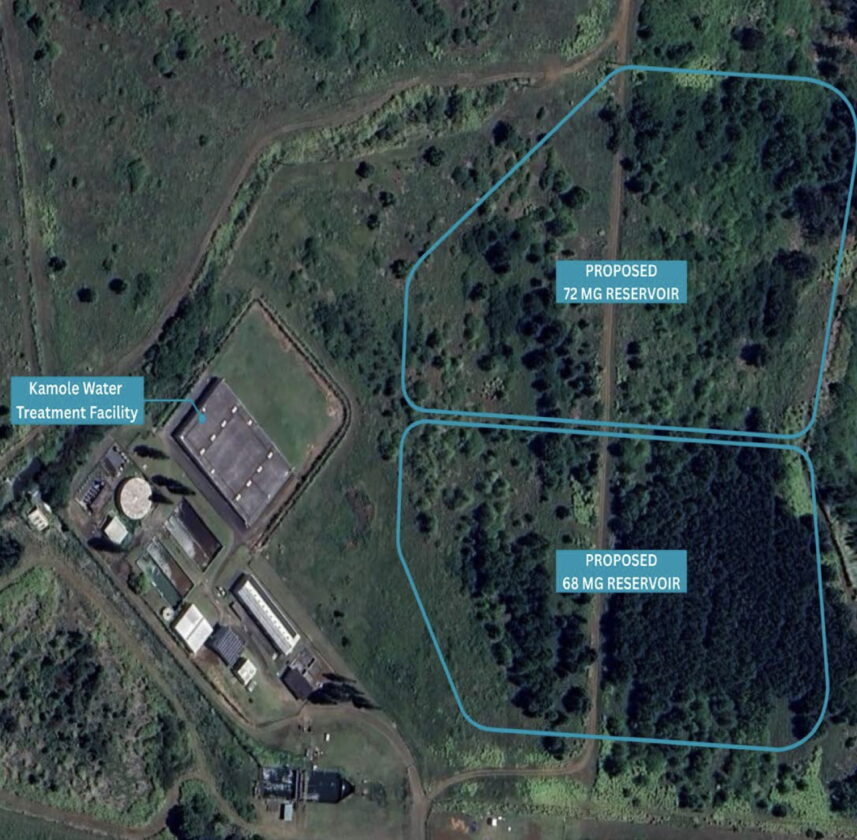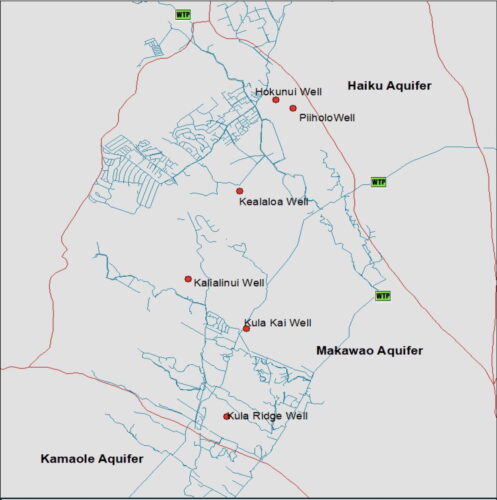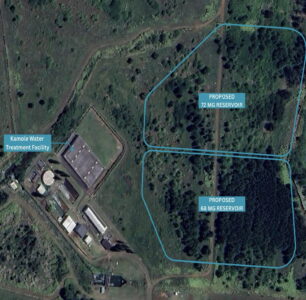Relief in the works for applicants on Upcountry water meter waitlist

The Maui County Department of Water Supply plans to develop two new reservoirs near the Kamaole Water Treatment Plant to help ease water shortages in the Upcountry area. Photo courtesy Maui County
John Stufflebean, director of the Maui County Department of Water Supply, said the department has developed a plan to start processing the list of people waiting for water meters in the Upcountry area.
According to the department, it halted accepting new applications for water meters for the Upcountry service area on Jan. 1, 2013. Stufflebean said part of the solution involves installing better water filters in Upcountry treatment plants by early 2026 that will increase the county’s capacity to process water.
Another part of the plan includes eventually developing six additional wells and two new reservoirs.
Stufflebean said two reservoirs near the Kamole Treatment Plant — with a capacity of 72 million gallons and 68 million gallons — are in the design stage.
He said the reservoirs would allow the capture of high-flow water. The reservoir would also allow any sediment to settle before treatment.
Stufflebean said the cost of one of the reservoirs includes $1.4 million for design in the 2026 budget and about $25 million for construction, and the department is seeking federal funding.
In long-term planning, the water department is also considering acquiring or drilling six additional wells in the Makawao aquifer area, including a well at Piiholo, Hokunui, Kealanoa, Kalialinui, Kula Kai and Kula Ridge.

The Maui County Department of Water Supply plans to develop six new wells in the Upcountry area. Photo courtesy Maui County
Stufflebean presented the department’s plan including studies and the proposed locations of potential projects during a presentation about developing Upcountry’s water resources Thursday at the Hannibal Tavares Community Center in Pukalani.
A similar presentation at Tavares Center is scheduled for 6 p.m. Oct. 28 to give anyone who was unable to attend the first meeting an opportunity to listen to the presentation, ask questions and offer comments.
During Thursday’s meeting, the water director received applause from the audience for his detailed presentation and willingness to field questions from members of the audience.
“I’m encouraged that they’re doing some improvements,” said Kula resident Bob Lake, who added that he has been waiting 22 years for a water meter. “They seem to have the right guy asking the right questions.”
Dick Mayer, a member of the Kula Community Association’s Water Task Force, said he was pleased with the presentation and got a lot of factual information from it, though some questions remain, such as what impact the projects might have on water rates.
According to Stufflebean, some 1,424 applicants are on the waitlist for water meters in Upcountry, and the department hasn’t been able to process the waiting list because the demand exceeds capacity by 4%.
The peak demand for water in the Upcountry area is about 10.1 million gallons a day, while the county can only supply a maximum of 9.7 million gallons a day.
“We already are in a situation where there’s not enough water to meet the existing demand,” he said.
Stufflebean said installing new filters at treatment plants in Upcountry will increase the treatment capacity by 1.5 million gallons a day. He said with the filters, the department plans to raise reliable capacity from 9.7 million gallons per day to 11.2 million.
“It will again allow us to process the meter list,” he said.
He said the project to replace the filters is estimated at $5 million and work is “well underway.”
He said the department is also examining its method of awarding meters on a first-come, first-served basis.
Stufflebean said about half of those who finally do get approved for a water meter end up turning down the offer because of the high cost of developing water to their residence. Installing meters based on the chronological method can also be inefficient too.
“You’re going to have one connection over here, and the next one’s over here, and the next one’s over here,” Stufflebean explained.
He said it would be better if individuals could group together so one property owner doesn’t have to shoulder the entire cost.
“There’s got to be a better way,” he said.


